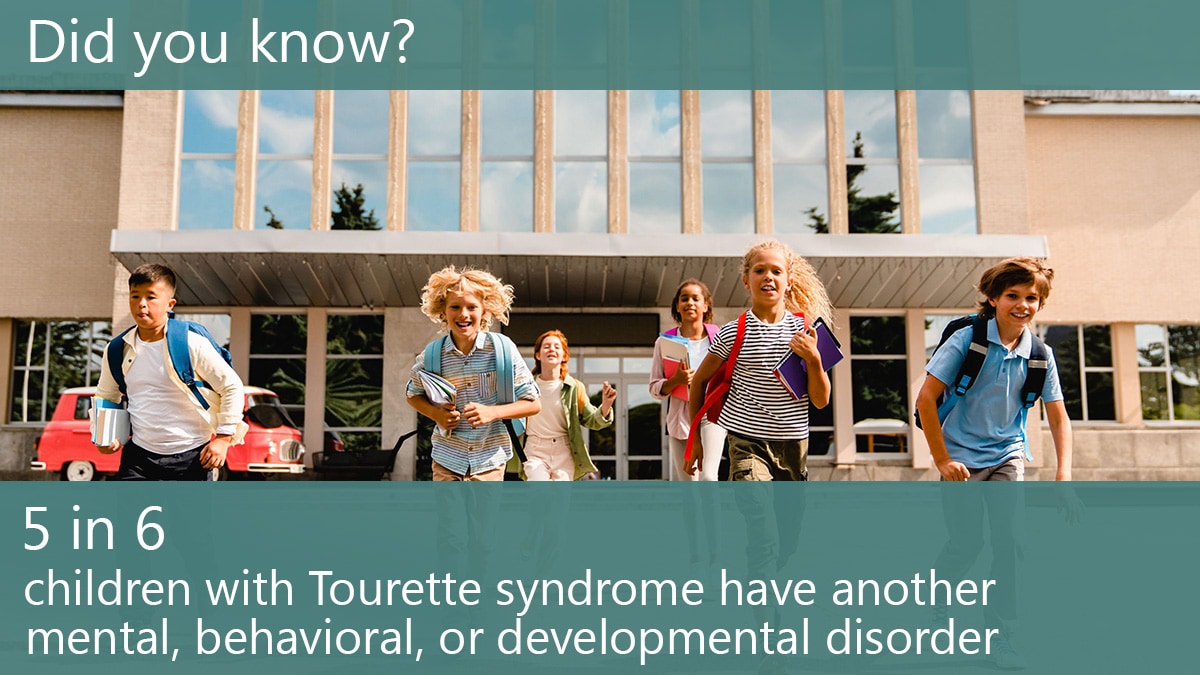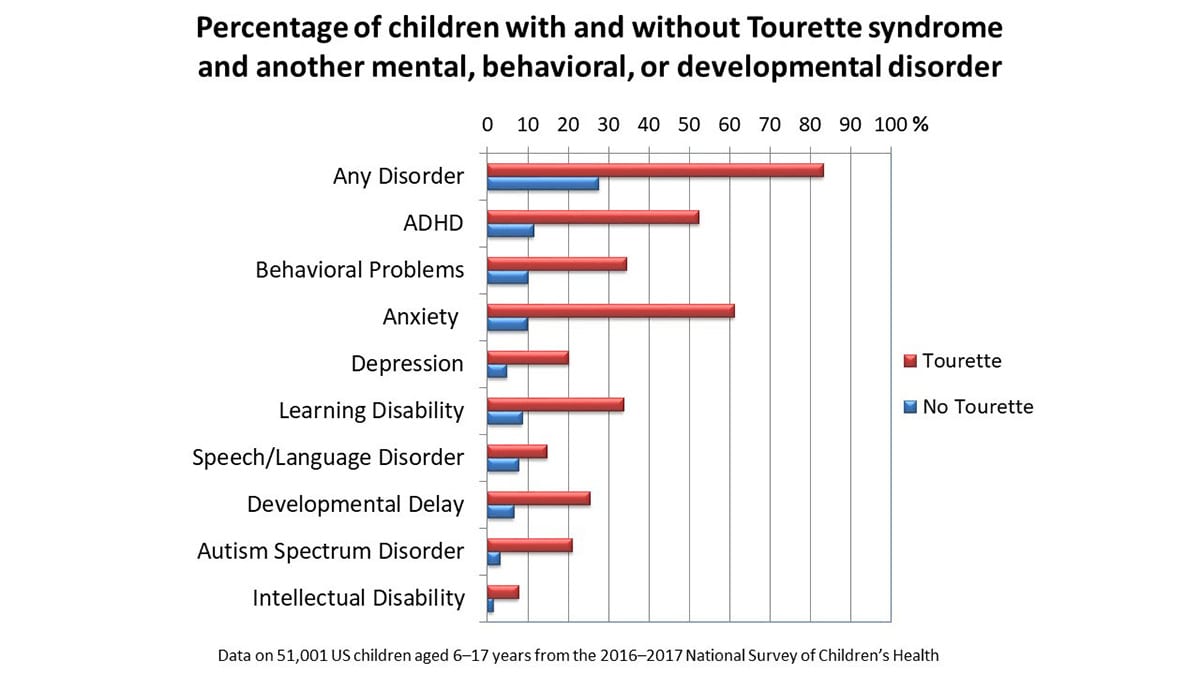At a glance
We do not know how many children have Tourette syndrome (TS). Studies estimate that 1 out of 162 children have TS. Many children diagnosed with TS also have been diagnosed with other mental, behavioral, or developmental disorders.

How many children have Tourette syndrome?
We do not know exactly how many children have Tourette syndrome (TS).
- Studies that included children with diagnosed and undiagnosed TS have estimated that 1 out of every 162 children (0.6%) have TS.1
- A CDC study using parent-reported data found that 1 out of every 333 (0.3%) children 3–17 years of age in the United States have received a diagnosis of TS; this is about 174,000 children in 2016–2019.2
- This suggests that about half of children with TS may not be diagnosed.
Among children diagnosed with TS in 2016-2017,3
- 44% have been reported as having moderate or severe TS.
- Boys were about three times more likely to have TS than girls.
- Children from all racial and ethnic groups or socio-economic backgrounds had similar estimates for diagnosis of TS.
- Children 12–17 years of age were more than twice as likely to have a diagnosis of TS than children 6–11 years of age.
Read more about the findings for 2016–2017 data and 2016–2019 data MMWR.
New research
Persistent tic disorders (including Tourette syndrome) may affect
About 1.4 million people in the U.S.
About 1 in 50 children aged 5-14 years
Estimating the number of people affected by these disorders is challenging and more information is needed.
How many children with Tourette syndrome have another disorder?
Among children diagnosed with TS:3
- 61% had anxiety problems
- 52% had ADHD
- 34% had behavioral problems, such as oppositional defiant disorder or conduct disorder
- 34% had learning disabilities
- 26% had developmental delays
- 21% had autism spectrum disorder
- 20% had depression
- 15% had speech or language problems
- 8% had intellectual disabilities
More than one third of people with TS also have obsessive-compulsive disorder.4


Impact of Tourette syndrome
Having TS can have an impact on many areas of life, particularly when children have another condition in addition to TS. Using data from CDC studies, the following are examples of the impact of TS.
Compared to children without TS, children with TS were more likely to5
- Have an Individualized Education Program (IEP)
- Have a parent contacted about school problems
- Not complete their homework
Once the presence of other disorders was taken into account, children with TS were still more likely to have an IEP compared to children without TS.
Compared to children without TS, children with TS were more likely to have5
- A chronic health condition
- A special healthcare need
- Received mental health treatment
- Needs for mental health care that were not met
Compared to children without TS, children with TS were less likely to have
- Received effective coordination of care
- A medical home
Compared to children without TS, children with TS were more likely to have parents with high levels of stress and frustration.6
Once the presence of other disorders was taken into account, parents of children with Tourette were still more likely to have high levels of stress and frustration.
Compared to children without TS, children with TS were more likely to struggle with7
- Social competence;
- Higher levels of behavioral problems; and
- Lower levels of social skills.
This is particularly true when children have moderate-to-severe TS and when they are diagnosed with other mental, emotional, or behavioral disorders.
Compared to children without TS, children with TS were2
- More likely to be the victim of bullying;
- More likely to be the perpetrator of bullying; and
- More likely to be both a victim and a perpetrator.
Bullying is most common among peers, but children with TS also experience being treated differently by teachers and other adults.8
Life course of Tourette syndrome
Tourette syndrome is a disorder that develops in childhood and changes over time. A survey of parents of children with Tourette syndrome found that:9
- Parents typically first noticed tics in children at about 6 years of age on average (in early elementary school).
- The average time from initially noticing tics to receiving a diagnosis of TS was about 2 years.
- The average age when TS was most severe was 9 years of age.
- Most parents reported that their child's tics were noticeable to strangers.
- The extent to which tics interfere with daily functioning was linked to how severe the symptoms were.
- Almost 70% of parents reported that major changes, like starting a new school, moving into a new class, or being tired, made their child's tics worse.
- About half of the parents reported that exercise or quiet hobbies made tics better.
In most cases, tics decrease during adolescence and early adulthood, and sometimes disappear entirely; however, many experience tics into adulthood and, in some cases, tics can become worse in adulthood.310 One study that followed youth with TS over time found that at 18 years of age, almost half of the youth had been tic-free the week before they were interviewed, about 1 in 10 had minimal tics, almost 3 in 10 had mild symptoms, and just over 1 in 10 had moderate-to-severe tics.3
- Knight T, Steeves T, Day L, Lowerison M, Jette N, Pringsheim T. Prevalence of tic disorders: A systematic review and meta-analysis. Pediatr Neurol. 2012;47(2)(Pediatr Neurol):77–90. doi:10.1016/j.pediatrneurol.2012.05.002
- Bitsko RH, Claussen AH, Lichstein J, et al. Mental Health Surveillance Among Children – United States, 2013 – 2019. MMWR Suppl. 2022;71(2):1-48.
- Charania SN, Danielson ML, Claussen AH, Lebrun-Harris LA, Kaminski JW, Bitsko RH. Bullying victimization and perpetration among US children with and without Tourette syndrome. J Dev Behav Pediatr. Published online May 26, 2021.
- Eapen V and Crncec R. Tourette syndrome in children and adolescents: Special considerations. J Psychosom Res. 2009;67(6):525–32. doi:10.1016/j.jpsychores.2009.08.003
- Claussen AH, Bitsko RH, Holbrook JR, Bloomfield J, Giordano K. Impact of Tourette syndrome on school measures in a nationally representative sample. J Dev Behav Pediatr. 2018;39(4):335–342.
- Bitsko RH, Danielson M, King M, Visser SN, Scahill L, Perou R. Health care needs of children with Tourette syndrome. J Child Neurol. 2013;28(12):1626–36.
- Robinson LR, Bitsko RH, Schieve LA, Visser SN. Tourette syndrome, parenting aggravation, and the contribution of co-occurring conditions among a nationally representative sample. Disabil Health J. 2013;6(1):26–35.
- Bitsko RH, Danielson ML, Leeb, RT, et al. Indicators of social competence and social participation among US children with Tourette syndrome. J Child Neurol. Published online June 9, 2020
- Ricketts EJ, Wolicki SB, Danielson ML, et al. Academic, interpersonal, recreational, and family impairment in children with Tourette syndrome and attention-deficit/hyperactivity disorder. Child Psychiatry Hum Dev. 2021.
- Wolicki SB, Danielson ML, Bitsko RH, et al. Children with Tourette syndrome in the United States: Parent-reported diagnosis, co-occurring disorders, severity, and influence of activities on tics. J Dev Behav Pediatr. 2019;40(6):407-414.
